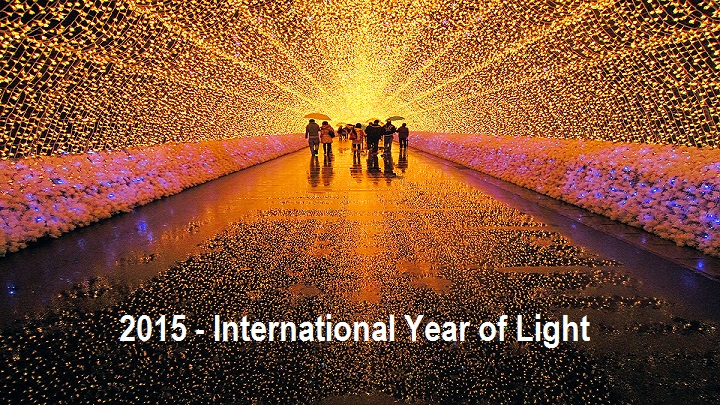
In this issue:

Celebrating Achievements in Optics & Light -Based Technologies
The International Year of Light and Light-Based Technologies (IYL 2015) is a global initiative adopted by the United Nations to raise awareness of how optical technologies promote sustainable development and provide solutions to worldwide challenges in energy, education, agriculture, communications and health. It also brings together scientists, researchers and industry professionals in a series of events that celebrate the advances in Optics and Light technologies. The Opening ceremony on Jan 19, 2015 in UNESCO headquarters in Paris was attended by over a 1000 participants, who enjoyed two days of elaborate displays and talks by thought leaders. The event also recognized the contributions of Ibn-Al-Haytham, considered by many to be the 'Father of Modern Optics'.
Born in the year 965 in Basra (middle-east), Ibn-Al-Haytham was one of the earliest scientists to study the characteristics of light and the mechanism of vision. His methods focused on investigation and seeking proof of his theories by way of experimentation. In that respect, he is often credited with laying the foundation of modern-day scientific method. His pioneering work 'Kitab-al-Manazir' - popularly known as the Book of Optics, influenced many Medieval and European Renaissance thinkers like Roger Bacon, Rene Descartes and Christian Huygens, who knew him as "Alhazen". The crater Alhazen on the Moon is named in his honor, as is the asteroid 59239 Alhazen.
From the study of optics over 1000 years ago, to discoveries in optical communication that power the internet today, IYL 2015 will celebrate many major scientific anniversaries that have been crucial to shaping modern life. IYL 2015 however, is not only about science, as advancements in art, culture, history and education are also the focus of many events. A complete listing of global events may be found at IYL Global Events
What the UN and affiliated event organizers hope to achieve with this initiative is deeper collaboration among international bodies in advancing photonics sciences, and projects for sustainable economic development in all parts of the world. The campaign encourages participation from students, researchers, professionals and organizations alike by providing easy-access event submissions at no cost.
A wide array of educational resources are freely available on the event website and blog, aimed at creating a deeper understanding of light and optics in everyday life, medicine, technology and the global economy. Laser based innovations and contributions of scientists in advancing laser science has particularly been highlighted. Read more at: IYL 2015 Lasers
Additional Resources:
2015 International year of Light: Light 2015
International Society for Optics & Photonics: SPIE
1001 Inventions and The World of Ibn-Al-Haytham: www.1001inventions.com
Lasers Used in Study of Conditioned Taste Aversion
Conditioned Taste Aversion (CTA) may be broadly defined as a condition in which an individual develops a distaste for a newly introduced food substance. Previous studies have failed to accurately identify the specific group of neurons responsible for CTA. Recently, researchers at the University of Washington have not only identified the neuronal populations responsible for inducing CTA, but have also shown that Optogenetic activation of these neurons is necessary and sufficient to induce CTA in mice. Laserglow Technologies' LRS 473nm Laser was used as an excitation source.
The researchers built upon previous studies that show that a certain section of the brain called Parabrachial Nucleus (PBN) has neurons responsible for taste, appetite suppression and CTA. In a previous experiment, they demonstrated that Calcitonin gene-related peptide (CGRP) neurons in the PBN are responsible for inducing appetite suppression, and inhibiting them reduced the effects of any external appetite suppressant (for example, lithium chloride).Moreover, electrolytic lesions of the external lateral section of PBN (PBel) caused a reduction in the symptoms of CTA. This meant that neurons responsible for CTA are present in the PBel section. Using this hypothesis, the research demonstrated that optogenetically induced neural activity in the PBel-CGRP neurons is necessary and sufficient to develop CTA.
The team believes that by use of Optogenetics, it might be possible to suppress or reduce CTA symptoms when neural activity in the region is inhibited. These findings have tremendous potential for further studies in the areas of eating disorders and nutrition.
The research was first published in The Journal of Neuroscience on March 18, 2015. To learn more about how the researchers proved their hypothesis and identified the neurons, go to: Journal of Neuroscience- March Article
Laser-Enabled Smart Glasses for Better Visibility
The development of a new retina imaging laser eyewear in Japan is poised to take the low-vision care industry by storm in 2017. In a prototype developed in collaboration with the Institute for Nano Quantum Information Electronics at the University of Tokyo, QD Laser Inc. has demonstrated the first smart device that could prove to be a viable alternative to laser eye surgery.
The device consists of a camera module in the center of the frame that captures the external image, and uses RGB semiconductor laser light reflected on a MEMS mirror to project a digital image directly onto the retina. This enables wide viewing, high brightness, focus-free vision- which means people with low or poor eyesight will see the image as sharply as those with normal eyesight.
The low-power consumption, small size and wide-area viewing are some characteristics the company believes are selling points over currently available Liquid Crystal Display (LCD) enabled eyewear.
The device is being developed further for applications in the industrial machine vision market by end of 2015, and as a wireless smart device for consumers by 2017. Read more at: QD Laser Inc Press Release
Additional Resources:
New Smart Glasses Rely On Laser Retinal Imaging: Laser Focus World Feature
Laser Glasses Aim to Counteract Low Vision: Photonics.com Article